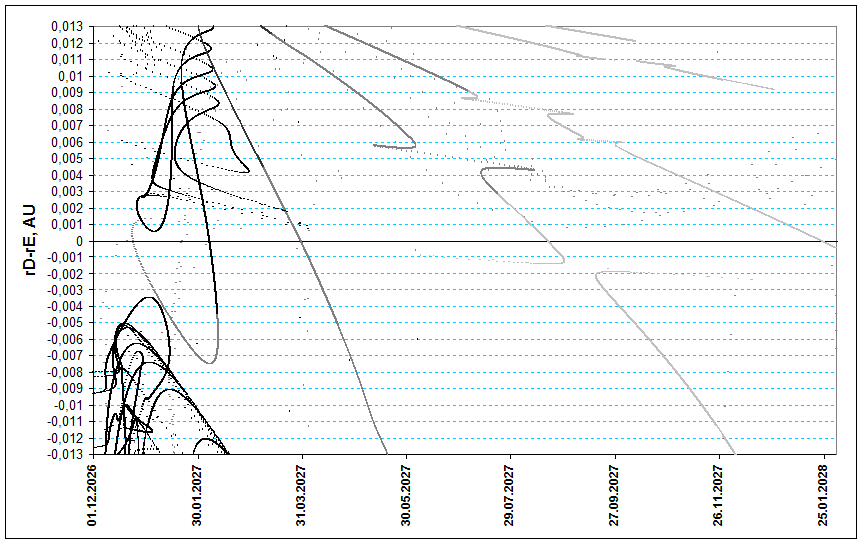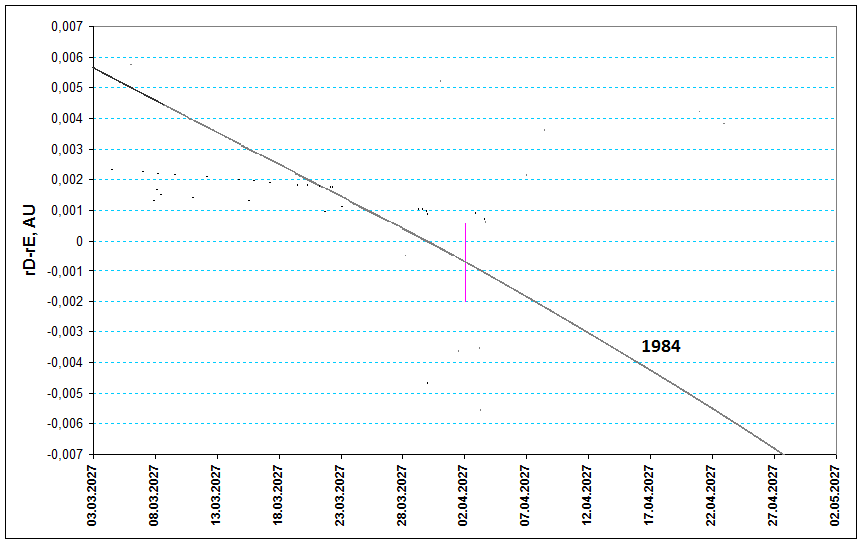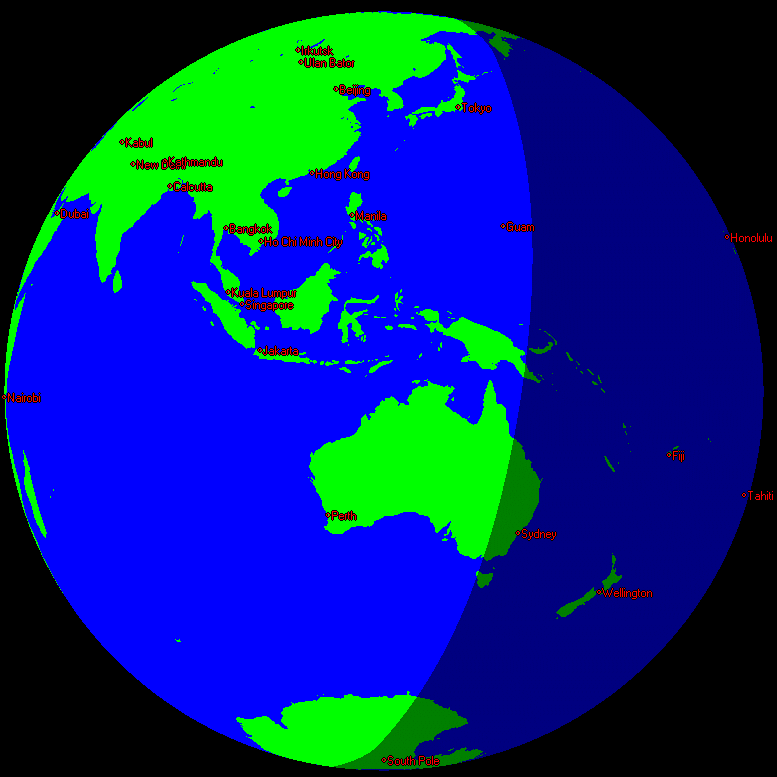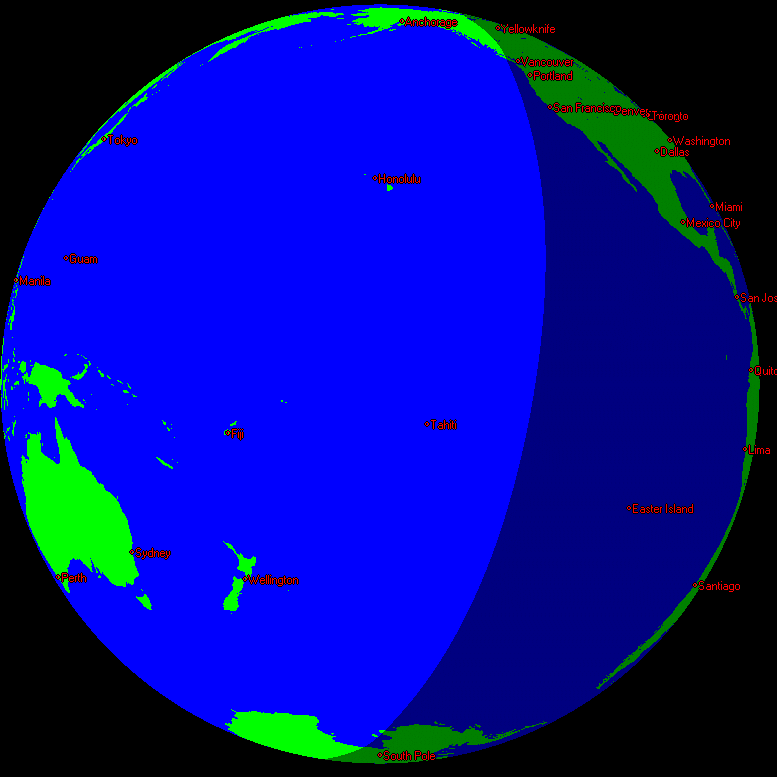252P-ids 2027: prediction of activity
to the list of predictions

Fig. 1. Space-temporal projection of 252P-ids trails parts onto their minimal distance passages in 2027 (correspondence between colours of the particles and their ejection velocities can be seen here).

Fig. 2. Detailed space-temporal projection of 252P-ids trails parts onto their minimal distance passages in 2027 (correspondence between colours of the particles and their ejection velocities can be seen here).
On 7 November 2026 the comet 252P/LINEAR passes its next perihelion. Perihelion distance is expected to be 1.0036 AU [6] and the distance between the Earth and the comet orbits will be 0.019 AU. Thans to such quite favorable geometry some encounters of the Earth with the comet 252P trails are expected in 2027.
The first possible activity enhancement is expected to be caused by fragments of 1963 and 1968 trails, with maxima expected from 14 to 16 UT on March 31. Ejection velocities of trails particles are from 7 to 9 m/s which is a favorable value. However density of these trails is very small, measuring from 1 to 4% of that for a 1 revolution Leonids trail. So far probability of any notable activity from these trails considered to be very low.
The second expected outburst is more interesting. It is connected to 1984 trail and its maximum is expected at 2:50 on April 2. Distance between the trail and the Earth will be 0.00072 AU, trail density is high - 528% of that for a 1 revolution Leonids trail, and ejection velocity of particles is 27.1 m/s. Therefore considering all these parameters it is expected that chances for some notable activity are very high, though we do not expect it to be very strong, with ZHR perhaps of 10-20.

Fig. 3. The Earth as seen from coming 252P-ids meteors (RA=77.4°, Dec=-12.9°) during the expected maximum time of outburst from 1963 and 1968 trails at 15:10 on March 31.
In case this activity occurs at the expected time it will be best visible in New Zealand and Pacific island to the north of it, as well as on the eastern coast of Australia.

Fig. 4. The Earth as seen from coming 252P-ids meteors (RA=76.0°, Dec=-11.5°) during the expected maximum time of outburst from 1984 trail at 2:50 on April 2.
If this outburst occurs at the expected time, then it will be visible across vast auqatory of the Pacific ocean and on many of its numerous islands, as well as on west coast of the USA and Mexico, thouth with the radiant not high in the sky for them.
The Moon will be in waning phase while the radiant of expected shower of the comet 252P is visible in the eveneing. So far the Moon won't create any problems for observations of possible activity of the comet 252P shower.
References
1. "Comet's dust 2.0" program by S. Shanov and S. Dubrovsky. [Used for orbital computations.]
2. E. Lyytinen, T. van Flandern "Predicting the strength of Leonid outbursts", 2000, Earth, Moon, and Planets, P. 149-166.
3. Jenniskens P. Meteor showers and their parent comets, 2006, 780 p. 4. Kasuo Kinoshita, http://jcometobs.web.fc2.com/ [Orbital elements of the comet 252P/LINEAR]
5. Hewgill G. Xearth 1.1.0 (Software program), 2003. 6. Seiichi Yoshida, http://aerith.net/comet/catalog/0252P/2026.html [Orbital elements of the comet 252P/LINEAR.].
The Moon will be in waning phase while the radiant of expected shower of the comet 252P is visible in the eveneing. So far the Moon won't create any problems for observations of possible activity of the comet 252P shower.
References
1. "Comet's dust 2.0" program by S. Shanov and S. Dubrovsky. [Used for orbital computations.]
2. E. Lyytinen, T. van Flandern "Predicting the strength of Leonid outbursts", 2000, Earth, Moon, and Planets, P. 149-166.
3. Jenniskens P. Meteor showers and their parent comets, 2006, 780 p. 4. Kasuo Kinoshita, http://jcometobs.web.fc2.com/ [Orbital elements of the comet 252P/LINEAR]
5. Hewgill G. Xearth 1.1.0 (Software program), 2003. 6. Seiichi Yoshida, http://aerith.net/comet/catalog/0252P/2026.html [Orbital elements of the comet 252P/LINEAR.].